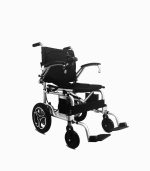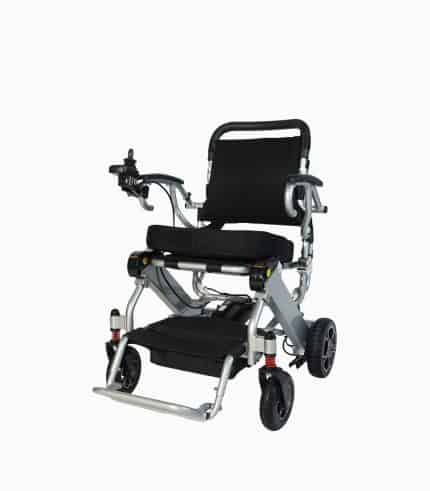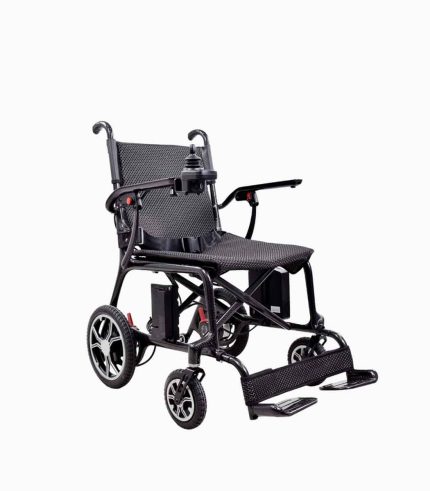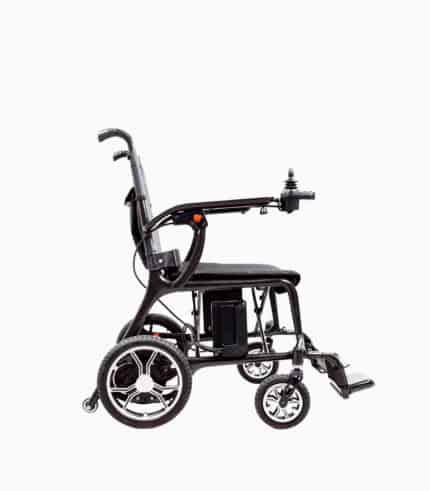Description
MWheel LW motorised electric wheelchair is one of the most affordable lightweight wheelchairs in the market. At just 16.3¹ kg, this electric wheelchair can be folded easily and carried on board cars and airlines.
The MWheel LW wheelchair is rear-driven by powerful dual 150W electric motors and a detachable 6 Ah Li-ion battery. There is a side compartment to store a spare battery for more extended travel.
MWheel LW comes with anti-tipper wheels mounted on the rear. In addition, it comes with intelligent braking, which automatically locks the wheels and prevents the wheelchair from sliding.
Lastly, a convenient USB charging port is just below the joystick to charge your smart devices.
The MWheel LW motorised electric wheelchair is probably the most affordable lightweight wheelchair on the market.
- 1. Weight of PMA is w/o battery.
*Product specifications subjected to change without notice.
- Note 1: As an electric wheelchair is a motorised device used in public paths, people are recommended to practice safe and cautious riding habit. Example, people must slow down when navigating a corner. Look out for potholes or uneven grounds. When travelling on slopes, try to enlist assistance from others.
- Note 2: If there are any changes to your health or condition, always seek your doctor's advise before you continue to use the electric wheelchair.
- Note 3: If unsure whether an electric wheelchair is suitable for you, always consult your doctor before purchase or using.
- Note 4: Electric wheelchairs are generally allowed on a flight. Do check with airline of choice beforehand as they may have to make prior arrangements.
SPECIFICATIONS
- Type: Motorised electric wheechair
- Battery type: Detachable Li-ion
- Drive: Rear driven, dual motor
- Max user weight: 100 kg
- Weight w/o batt: 14.6 kg
- Weight w/ 1 x batt: 16 kg
- Dimensions: 900 x 550 x 880 mm
- Seat width: 400 mm
- Seat length: 390 mm
- Backrest height: 430 mm
- Backrest width: 380 mm
- Recline angle: Fixed, 5°
- With effect from 1 Feb 2019, the maximum device speed for mobility scooters is 10 km/h as stipulated in the Active Mobility Act. For more details, please click here.
- Ministry of Transport (MOT) announced on 5 Mar 2024 that the maximum device speed for mobility scooters will be lowered to 6 km/h. This new regulation will take effect some time after Mar 2025. Genuine mobility scooter users may also continue to use their existing devices until their devices reach their end of life, so long as they travel within 6 km/h. For more details, please click here.
- Personal Mobility Aids (PMAs) such as mobility scooters are not required to register with Land Transport Authority (LTA) or fulfil UL2272 certifications. For more details, please click here.
- Ministry of Transport (MOT) announced on 5 Mar 2024 that only users certified with relevant medical needs or walking difficulties are allowed to use mobility scooters. This new regulation will take effect some time after Mar 2025. More details will be available in due course. Users do not have to approach healthcare professionals to obtain certification yet. For more details, please check here.
- 1 year (carry-in) under normal usage.
- Does not include wear & tear and consumable parts, not limited to tyres, brake pads, chain, sprockets.
- Others items exclude from warranty are paint, chrome components, polished surfaces, saddles and handgrips where deterioration may be caused by normal usage, poor maintenance or natural degradation of surfaces.
- Does not cover damages due to water/moisture, accident and misuse.
- Warranty may be void if critical components are modified or replaced with non original or non compatible parts.
- Not applicable for international orders. (ie outside of Singapore)
For full warranty terms and conditions, refer to Warranty Policy.
Trains
- Approach MRT station staff for assistance when boarding and alighting. The friendly staff can escort passengers-in-wheelchair to the platform and arrange for assistance at the destination station.
- There usually two wheelchair-accessible train carriages per train. To locate them, look for wheelchair indicators on the platform floor or screen doors. These indicators are usually near lifts.
- There is at least one barrier-free entrance in every train station and wider fare gates.
- There is accessible elevator service to all levels in the stations.
Bus
- Approach Bus Captains for assistance when boarding and alighting Wheelchair Accessible Bus (WAB). The friendly Bus Captains are trained to aid passengers-in-wheelchair when needed. They can operate the ramps on the WABs for boarding and alighting.
- When alighting from WABs, passengers-in-wheelchair should press the blue button to alert the Bus Captain.








































